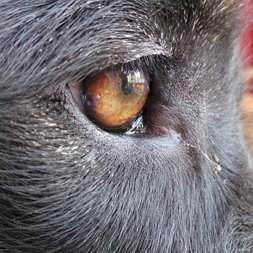What does the world look like, seen through a dog’s eyes? First of all, he or she doesn’t see a full rainbow of colors. Cone cells in the retina are responsible for color vision. Humans have three of these color-receptive cones. (Someone who is colorblind may be missing a cone or may have a defective one.) Dogs have only two color-receptive cones in each eye and see the world in blues, yellow and grays. But even within that range of colors, there are gradations of brightness. Dogs may use brightness to help them distinguish items in their environment.
But within the range of colors that dogs see, can they make decisions when color is the only clue to a reward? By setting up trials that associated a reward with a color card (either yellow or blue) and then switching the shade of the color in subsequent trials, a study showed that dogs could use color consciously to gain a reward.
I’ve noticed that when I am driving down the road with my dog, Cooper, in the back seat, he can spot other dogs reliably. Were it not for the actual experience, I would have predicted that he would respond to cows, horses and other animals on four legs as if they were dogs when viewed from the car window. But no, even at a distance, he knows a dog from a horse. Research confirms what I’ve learned from experience: that dogs can differentiate between species. Show them photos of dogs, be they pugs or St. Bernards or Mastiffs, they can tell they are dogs.
Another study showed that “dogs fixed their gaze more often on familiar faces and eyes rather than strange ones, i.e. dogs scanned familiar faces more thoroughly.” They know us, and also family pets, even when it’s only an image of us.
What about visual acuity? I was pretty sure dogs’ acuity wasn’t as good as humans when Cooper was standing in our pasture one day and I came down the hill toward him from some distance away. Actually, I put him at another disadvantage: I stuck my arms in the air and lumbered like a zombie. He looked at me, alert with suspicion. I could see he was alarmed so I dropped the zombie impersonation, and he quickly discerned that it was “mom.” Then he came bounding to meet me.
As for the numbers, dogs have approximately 20/80 vision, while humans, ideally, have 20/20. That means that you can see at 80 feet what a dog can see clearly at 20 feet. But they also are keen motion detectors and probably depend on the way we move to tell who we are when we are still out of focus.
Each of our eyes has a field of vision and part of that field overlaps. Our brain takes the slightly different images from each eye and interprets them to deliver a 3D image of what we see. This allows us to have excellent depth perception. The place where the visual field in both eyes overlap is called the binocular field. Humans have about a 120-degree binocular field out of a total field of vision of 180 degrees or so. Because dogs’ eyes are placed more on the sides of their heads, they have better peripheral vision, but by the same token, their binocular field, where the image overlaps, is only about half that of humans. A dog can see someone sneaking up from the side better than we can, but has a narrower binocular field of keen depth perception, called depth sensation in dogs.
Dogs have better night vision than humans because they have more rods, or light receptors in their eyes. According to servicedogcentral, it is estimated that a dog’s eye for detail is six times poorer than that of a human. “On the other hand, because they have so many more rods than humans, dogs can see in light five times dimmer than humans can.”
You win some, you lose some. We both have our advantages.
See how the world might look to a dog.
Photo credit: By Karruption (Own work) [CC BY-SA 3.0 (http://creativecommons.org/licenses/by-sa/3.0)], via Wikimedia Commons

